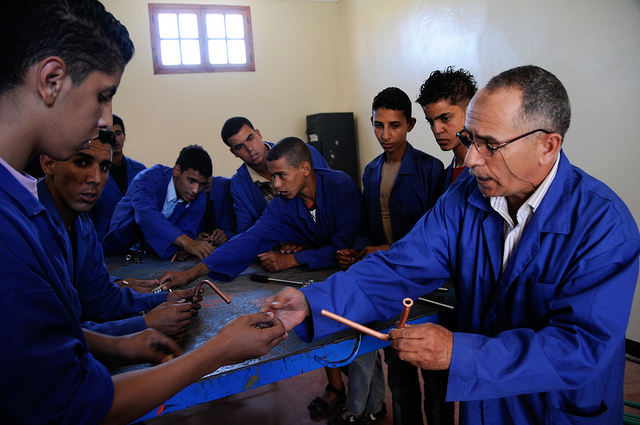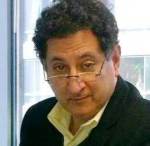Updated
Visions for Valuing Youth to Build Morocco’s Future – Jean R. AbiNader

Students at a vocational education and training center; National Initiative for Human Development Support Project (INDH) Photo: Dana Smillie / World Bank
Jean R. AbiNader
October 25, 2018

Jean R. AbiNader, Moroccan American Center
In its recent report on the status of youth, the Social, Economic and Environment Council (CESE) identified important challenges to King Mohammed VI’s mandate, in his recent Youth Day address, to increase youth employment via “a new integrated national initiative for Moroccan youth.” To emphasize his point, the King met with the education committee in early October to focus on the vocational training sector as an immediate priority. “The sovereign gave the government three weeks to prepare a full draft aimed at adapting training in “traditional professions” that are the main employers of young people. These professions are namely services, construction, agriculture, fishing, water, energy and crafts.”
By now the outlines of the crisis are clear. “Two-thirds of young people between the ages of 15-34 are out of school, 20% are unemployed, 50% are on low pay, 82% are not physically active, 75% have no social security coverage, and 20% suffer from psychological disorders.” Both university-educated and other young people in the 15-34 years old segment lack access to decent work with benefits, regular pay, and some job security. This economic malaise is leading to a sense of exclusion from public life and the country’s political scene, as evidenced by the low voter participation of this group.
Not only do they feel marginalized, the report notes, but they are increasingly distrustful of institutions and public offices. The CESE recommends that the country adopt an integrated and strategic effort with “pragmatic and realistic answers around nine related areas of action that are dependent upon one another. These are education and training; employability; prevention of abuse, promotion of physical and psychological health and social protection; addressing vulnerability, poverty, precariousness, and exclusion; youth engagement; encouraging the foundation of values and sense of belonging of young people to the nation; culture, sport, and activities centers; building awareness of and respect for the environment and environmental education; and a commitment to international understanding and world issues.
The report concludes that “The new initiative must be based on a cross-cutting vision, itself supported by coherent and integrated management involving all stakeholders.” To stimulate progress and decrease the rich-poor gap, Morocco’s “primary challenge” will be to promote gender equality by “boosting female entrepreneurship, investing in innovative start-ups, and ensuring linkages between formal training and labor market’s demands.”
At the fifth annual Middle East and Africa Media Summit in Dubai, there was an extensive interview with Andrew Baird, CEO of Education for Employment, regarding Morocco’s progress and challenges in youth employment, which touched on many aspects of the CESE report. The article in Morocco World News provided the basic information. “The current unemployment rate is officially 10.5 percent, with an increase of 0.3 percent since last year. Morocco’s Economic, Social, and Environmental Council (CESE) stated in its 2017 report that young people suffer the highest unemployment rates. High youth unemployment not only hinders economic growth through the inefficient use of human capital, it contributes to the political, economic, and social exclusion of Moroccan youth and has stoked social unrest in the country.”
It goes on to note that high unemployment results from several factors. The economy not growing fast enough to create sufficient valued employment. The number of university graduate has increased from 43,000 to 120,000 in the last five years and many prefer the stability of the public sector rather than the uncertainty of private sector employment.
Small and medium enterprises make up the majority of Moroccan companies, many of which do not provide the standard benefits, salary, and training of the larger companies, and just over 52% of the actively employed population does not hold a university degree. In addition, corruption and nepotism contribute to eroding incentives for youth to pursue employment in both the public and private sectors.
More than 38,000 Moroccans are studying abroad, and 91% of Moroccan professionals aged 35 and younger wish to work abroad, in search of better work conditions and quality of life, including health care and comfort, thus contributing to the country’s brain drain. “The CESE’s report confirmed that the exclusion of university graduates is often due to the fact that the job market favors people with experience, and the mismatch of skills between graduates and available positions.”
What to do? Despite Morocco’s success in creating manufacturing jobs in the automotive and aeronautics sectors, some 300,000 by 2020, Mr. Baird’s concern is that “The government’s role is not necessarily to create jobs. It’s to create an environment where jobs can be created to attract both foreign and local investments.” So a broad effort to engage the private sector and putting in place programs to support the growth of small and medium enterprises are critical.
Baird was optimistic regarding Morocco’s economy, predicting it would generate more jobs in the coming years. “It’s hard to predict because it depends on a number of factors that are not in control,” said Baird. “But as long as there is a more or less stable economy, I anticipate that the more employment [will be] generated.” He added, “Because of demographics, in order to even stay stable you have to increase the rate of job creation, more and more jobs, year after year, just to absorb what’s coming in.”
In contrast, BMI research group forecasted, on May 2018, high unemployment throughout the next decade due to the expanding workforce, unmet demand for technical positions, and a decline in job creation in traditional professions.
Looking at the automotive and aeronautics sectors as success stories, Baird believes that Morocco should strategically marry the private sector’s needs and the educational system with the government adopted policies. He also asserted that vocational training needs to be reformed, increasingly urgent in light of the King’s restatement of his call for a new model for education and vocational training.
Another area that requires heightened attention is to better ensure the sustainability of access to water for consumption and agriculture, which is still the largest employer in the country. While the government insists that it is working on solutions, the King once again mentioned his dissatisfaction over the pace of implementing projects aimed to end water scarcity, instructing that construction of a series of dams was to begin immediately, especially in rural areas.
It remains to be seen whether this set of programs will curb water shortage in the country in the future.
David Cowan, economist at CitiBank noted that there should be more focus on investments in agriculture, especially in rural areas to ensure agricultural development across the country. “Go back to investing in agriculture. You can’t have industrial growth everywhere.”
There is no lack of information on what will propel employment, sustain economic growth, and provide for a more inclusive and equitable economy. How these can be integrated into a national strategy that lifts up all youth, while providing the skill sets and conditions for fair employment, is the work for a generation, beginning now.